Self-Cleaning Road Marking Paints for Improved Road Safety: Multi-Scale Characterization and Performance Evaluation Using Rhodamine B and Methylene Blue as Model Pollutants
Abstract
1. Introduction
2. Methodology
2.1. Materials
2.2. Methods
2.2.1. Paint Functionalization and Sample Preparation
2.2.2. Sample Pollution
2.2.3. Light Exposure
2.2.4. Self-Cleaning Ability Assessment
Visual Analysis
Cielab Color Space
Diffuse Reflectance Spectroscopy
Digital Image Processing
2.2.5. Chemical and Morphological Assessment
Fourier Transform Infrared Spectroscopy
Scanning Electron Microscopy and Energy Dispersive Spectroscopy
X-Ray Diffraction
3. Results and Discussion
3.1. Visual Analysis
3.2. CIELAB Color Space
3.3. Diffuse Reflectance Spectroscopy
3.4. Digital Image Processing
3.5. Fourier Transform Infrared Spectroscopy
3.6. Scanning Electron Microscopy and Energy Dispersive Spectroscopy
3.7. X-Ray Diffraction
4. Conclusions
- The grouping of images from the visual analysis technique displayed that over the light irradiation periods, the samples functionalized with higher amounts of TiO2 showed greater discoloration.
- CIELAB color space revealed that the samples 2% and 3% exhibited higher color variation and photocatalytic efficiency, regardless of pollutant model.
- Diffuse reflectance spectroscopy confirmed photocatalytic efficiency for the samples 2% and 3% up to 4.25 and 5.7 times higher in comparison with the reference sample, respectively.
- Digital image processing detected pollutant degradation for the samples 2% and 3% up to 4.5 and 7.7 times higher than the reference sample, respectively.
- CIELAB color space and diffuse reflectance spectroscopy provided measurements on specific points of the sample surface, while digital image processing offered comprehensive pollutant degradation information from the entire specimen surface.
- Methylene Blue demonstrated high degradation rates in the initial minutes of the irradiation, revealing a suitable pollutant model for short-term assessment tests.
- Rhodamine B proved to be a stable dye and a suitable pollutant model for long-term testing, with significantly reduced and similar discoloration rates for both samples non-functionalized or non-irradiated.
- The combined analysis of the FTIR, SEM and EDS tests revealed the presence of PIBMA in the binder, calcite as the filler, and TiO2 as the pigment of the commercial paint, as well as the increase in TiO2 in the chemical and morphological evaluation of the paint after functionalization.
- XRD analysis evidenced the presence of anatase crystalline phase of TiO2 exclusively in functionalized paints.
- Based on these results, it was demonstrated that the mass incorporation of nano-TiO2 into the RM paint conferred self-cleaning capacity. Furthermore, chemical and morphological analysis highlighted the increase in TiO2 in the chemical composition, as well as the presence of TiO2 in the desired crystalline state, anatase, confirmed the successful functionalization process.
Author Contributions
Funding
Institutional Review Board Statement
Informed Consent Statement
Data Availability Statement
Conflicts of Interest
References
- Burghardt, T.E.; Pashkevich, A.; Babić, D.; Mosböck, H.; Babić, D.; Żakowska, L. Microplastics and Road Markings: The Role of Glass Beads and Loss Estimation. Transp. Res. D Transp. Environ. 2022, 102, 103123. [Google Scholar] [CrossRef]
- Burghardt, T.E.; Pashkevich, A. Materials Selection for Structured Horizontal Road Markings: Financial and Environmental Case Studies. Eur. Transp. Res. Rev. 2020, 12, 1–10. [Google Scholar] [CrossRef]
- Burghardt, T.E.; Maki, E.; Pashkevich, A. Yellow Thermoplastic Road Markings with High Retroreflectivity: Demonstration Study in Texas. Case Stud. Constr. Mater. 2021, 14, e00539. [Google Scholar] [CrossRef]
- Villa, C.; Brémond, R.; Eymond, F.; Saint-Jacques, E. Characterization of Luminescent Road Markings. Light. Res. Technol. 2022, 55, 459–473. [Google Scholar] [CrossRef]
- Babić, D.; Burghardt, T.E.; Babić, D. Application and Characteristics of Waterborn Road Marking Paint. Int. J. Traffic Transp. Eng. 2015, 5, 150–169. [Google Scholar] [CrossRef]
- Pocock, B.W.; Rhodes, C.C. Principles of Glass-Bead Reflectorization. Highw. Res. Board Bull. 1952, 57, 32–48. [Google Scholar]
- Dimauro, G.A.; Cafiso, S.; Ghaderi, O.; Pappalardo, G. Development of Decay Curve for Paint Pavement Marking Using Machine Learning and Generalized Estimation Equation. J. Infrastruct. Preserv. Resil. 2025, 6, 15. [Google Scholar] [CrossRef]
- Burghardt, T.E.; Pashkevich, A. Green Public Procurement Criteria for Road Marking Materials from Insiders’ Perspective. J. Clean. Prod. 2021, 298, 126521. [Google Scholar] [CrossRef]
- Pereira, A.P.; Ribeiro, J.L.; Oliveira, A.C.F.; Vasconcelos, C.K.B.; Viana, M.M.; de Lins, V.F.C. Lignin-Modified Road Marking Paint: Weathering Aging Studies. REM—Int. Eng. J. 2021, 74, 225–233. [Google Scholar] [CrossRef]
- Giuliani, F.; Autelitano, F. Revêtements Routiers Photoluminescents: Étude Expérimentale Préliminaire En Laboratoire. Matériaux Tech. 2014, 102, 603. [Google Scholar] [CrossRef]
- Segundo, I.R.; Freitas, E.; Branco, V.T.F.C.; Landi, S.; Costa, M.F.; Carneiro, J.O. Review and Analysis of Advances in Functionalized, Smart, and Multifunctional Asphalt Mixtures. Renew. Sustain. Energy Rev. 2021, 151, 111552. [Google Scholar] [CrossRef]
- Burghardt, T.E.; Popp, R.; Helmreich, B.; Reiter, T.; Böhm, G.; Pitterle, G.; Artmann, M. Visibility of Various Road Markings for Machine Vision. Case Stud. Constr. Mater. 2021, 15, e00579. [Google Scholar] [CrossRef]
- Gibbons, R.B.; Williams, B.; Cottrell, B. Assessment of Durability of Wet Night Visible Pavement Markings. Transp. Res. Rec. J. Transp. Res. Board 2013, 2337, 67–73. [Google Scholar] [CrossRef]
- Pereira Lessa, F.; Lima, O., Jr.; Margalho, É.; Pinheiro, C.; Rocha Segundo, I.; Oliveira Carneiro, J. Application of Nano-TiO2 and Micro-ZnO on Cementitious Surfaces for Self-Cleaning Façades by Spray Coating and Dip Coating: A Comparative Study. J. Build. Pathol. Rehabil. 2025, 10, 16. [Google Scholar] [CrossRef]
- Rocha Segundo, I.; Ferreira, C.; Freitas, E.F.; Carneiro, J.O.; Fernandes, F.; Júnior, S.L.; Costa, M.F. Assessment of Photocatalytic, Superhydrophobic and Self-Cleaning Properties on Hot Mix Asphalts Coated with TiO2 and/or ZnO Aqueous Solutions. Constr. Build. Mater. 2018, 166, 500–509. [Google Scholar] [CrossRef]
- Reza Omranian, S.; Geluykens, M.; Van Hal, M.; Hasheminejad, N.; Rocha Segundo, I.; Pipintakos, G.; Denys, S.; Tytgat, T.; Fraga Freitas, E.; Carneiro, J.; et al. Assessing the Potential of Application of Titanium Dioxide for Photocatalytic Degradation of Deposited Soot on Asphalt Pavement Surfaces. Constr. Build. Mater. 2022, 350, 128859. [Google Scholar] [CrossRef]
- Paramés, J.; de Brito, J. Materiais de Construção Nanotecnológicos de Auto-Limpeza-Self-Cleaning Nanotechnologic Construction Materials. Teor. E Prática Na Eng. Civ. 2010, 15, 55–62. [Google Scholar]
- Van Hal, M.; Verbruggen, S.W.; Yang, X.-Y.; Lenaerts, S.; Tytgat, T. Image Analysis and in Situ FTIR as Complementary Detection Tools for Photocatalytic Soot Oxidation. Chem. Eng. J. 2019, 367, 269–277. [Google Scholar] [CrossRef]
- Smits, M.; kit Chan, C.; Tytgat, T.; Craeye, B.; Costarramone, N.; Lacombe, S.; Lenaerts, S. Photocatalytic Degradation of Soot Deposition: Self-Cleaning Effect on Titanium Dioxide Coated Cementitious Materials. Chem. Eng. J. 2013, 222, 411–418. [Google Scholar] [CrossRef]
- Silva, A.S.; Borsoi, G.; Parracha, J.L.; Flores-Colen, I.; Veiga, R.; Faria, P.; Dionísio, A. Evaluating the Effectiveness of Self-Cleaning Products Applied on External Thermal Insulation Composite Systems (ETICS). J. Coat. Technol. Res. 2022, 19, 1437–1448. [Google Scholar] [CrossRef]
- Pal, S.; Contaldi, V.; Licciulli, A.; Marzo, F. Self-Cleaning Mineral Paint for Application in Architectural Heritage. Coatings 2016, 6, 48. [Google Scholar] [CrossRef]
- Quan, X.; Yang, L.; Li, H.; Chen, Y.; Shi, S. Performance Evaluation of a Multifunctional Road Marking Coating for Tunnels Based on Nano SiO2 and TiO2 Modifications. Buildings 2024, 14, 459. [Google Scholar] [CrossRef]
- Taheri, M.; Jahanfar, M.; Ogino, K. Self-Cleaning Traffic Marking Paint. Surf. Interfaces 2017, 9, 13–20. [Google Scholar] [CrossRef]
- Lima, O.; Segundo, I.R.; Mazzoni, L.N.; Freitas, E.; Carneiro, J. Improving the Road Safety and the Service Life of Road Markings through Self-Cleaning Ability. In Bituminous Mixtures and Pavements VIII; CRC Press: London, UK, 2024; pp. 673–680. [Google Scholar]
- Stefan, M. More than Just Light. Solutions in Ultraviolet Light. In 100 Years of Innovation; OSRAM: Munich, Germany, 2016; Volume 24. [Google Scholar]
- Ines, M.; Paolo, P.; Roberto, F.; Mohamed, S. Experimental Studies on the Effect of Using Phase Change Material in a Salinity-Gradient Solar Pond under a Solar Simulator. Sol. Energy 2019, 186, 335–346. [Google Scholar] [CrossRef]
- Robertson, A.R. The CIE 1976 Color-difference Formulae. Color Res Appl 1977, 2, 7–11. [Google Scholar] [CrossRef]
- Munafò, P.; Quagliarini, E.; Goffredo, G.B.; Bondioli, F.; Licciulli, A. Durability of Nano-Engineered TiO2 Self-Cleaning Treatments on Limestone. Constr. Build. Mater. 2014, 65, 218–231. [Google Scholar] [CrossRef]
- Kalyoncuoğlu, Ü.T.; Yilmaz, B.; Sipahi, C. Determination of the Degree of Conversion, the Diffuse Reflectance, and the Color Stability after Different Aging Processes of Gingiva-colored Composite Resins. J. Prosthodont. 2023, 32, 743–751. [Google Scholar] [CrossRef] [PubMed]
- Thornton, B.T.E.; Harrison, A.; Pham, A.L.; Castano, C.E.; Tang, C. Polyaniline-Functionalized Nanofibers for Colorimetric Detection of HCl Vapor. ACS Omega 2018, 3, 3587–3591. [Google Scholar] [CrossRef] [PubMed]
- Li, J.; Wan, X.; Bu, Y.; Li, C.; Liang, J.; Liu, Q. In Situ Identification of Pigment Composition and Particle Size on Wall Paintings Using Visible Spectroscopy as a Noninvasive Measurement Method. Appl. Spectrosc. 2016, 70, 1900–1909. [Google Scholar] [CrossRef]
- Qiu, Y.; Wu, G.; Xiao, Z.; Guo, Y.; Zhang, X.; Liu, K. An Extreme-Learning-Machine-Based Hyperspectral Detection Method of Insulator Pollution Degree. IEEE Access 2019, 7, 121156–121164. [Google Scholar] [CrossRef]
- Huang, Z.; Shimizu, T.; Senz, S.; Zhang, Z.; Geyer, N.; Gösele, U. Oxidation Rate Effect on the Direction of Metal-Assisted Chemical and Electrochemical Etching of Silicon. J. Phys. Chem. C 2010, 114, 10683–10690. [Google Scholar] [CrossRef]
- Segundo, I.R.; Zahabizadeh, B.; Landi, S.; Lima, O.; Afonso, C.; Borinelli, J.; Freitas, E.; Cunha, V.M.C.F.; Teixeira, V.; Costa, M.F.M.; et al. Functionalization of Smart Recycled Asphalt Mixtures: A Sustainability Scientific and Pedagogical Approach. Sustainability 2022, 14, 573. [Google Scholar] [CrossRef]
- Carneiro, J.O.; Azevedo, S.; Teixeira, V.; Fernandes, F.; Freitas, E.; Silva, H.; Oliveira, J. Development of Photocatalytic Asphalt Mixtures by the Deposition and Volumetric Incorporation of TiO2 Nanoparticles. Constr. Build. Mater. 2013, 38, 594–601. [Google Scholar] [CrossRef]
- Lima, O.; Afonso, C.; Rocha Segundo, I.; Landi, S.; Homem, N.C.; Freitas, E.; Alcantara, A.; Branco, V.C.; Soares, S.; Soares, J.; et al. Asphalt Binder “Skincare”? Aging Evaluation of an Asphalt Binder Modified by Nano-TiO2. Nanomaterials 2022, 12, 1678. [Google Scholar] [CrossRef]
- Folli, A.; Jakobsen, U.H.; Guerrini, G.L.; Macphee, D.E. Rhodamine B Discolouration on TiO2 in the Cement Environment: A Look at Fundamental Aspects of the Self-Cleaning Effect in Concretes. J. Adv. Oxid. Technol. 2009, 12, 126–133. [Google Scholar] [CrossRef]
- Afonso, C.; Lima, O.; Segundo, I.R.; Landi, S.; Margalho, É.; Homem, N.; Pereira, M.; Costa, M.F.M.; Freitas, E.; Carneiro, J. Effect of Iron-Doping on the Structure and Photocatalytic Activity of TiO2 Nanoparticles. Catalysts 2023, 13, 58. [Google Scholar] [CrossRef]
- Katzenstein, J.M.; Janes, D.W.; Hocker, H.E.; Chandler, J.K.; Ellison, C.J. Nanoconfined Self-Diffusion of Poly(Isobutyl Methacrylate) in Films with a Thickness-Independent Glass Transition. Macromolecules 2012, 45, 1544–1552. [Google Scholar] [CrossRef]
- Knapp, A.M.; Halloran, J.W. Characterization of Thermoplastic Blends as Binders for Ceramics. J. Am. Ceram. Soc. 2006, 89, 3010–3018. [Google Scholar] [CrossRef]
- Aguilar-Rodríguez, P.; Mejía-González, A.; Zetina, S.; Colin-Molina, A.; Rodríguez-Molina, B.; Esturau-Escofet, N. Unexpected Behavior of Commercial Artists’ Acrylic Paints under UVA Artificial Aging. Microchem. J. 2021, 160, 105743. [Google Scholar] [CrossRef]
- Ortiz-Herrero, L.; Cardaba, I.; Bartolomé, L.; Alonso, M.L.; Maguregui, M.I. Extension Study of a Statistical Age Prediction Model for Acrylic Paints. Polym. Degrad. Stab. 2020, 179, 109263. [Google Scholar] [CrossRef]
- Rocha Segundo, I.; Landi, S., Jr.; Margaritis, A.; Pipintakos, G.; Freitas, E.; Vuye, C.; Blom, J.; Tytgat, T.; Denys, S.; Carneiro, J. Physicochemical and Rheological Properties of a Transparent Asphalt Binder Modified with Nano-TiO2. Nanomaterials 2020, 10, 2152. [Google Scholar] [CrossRef]
- Tsebriienko, T.; Popov, A.I. Effect of Poly(Titanium Oxide) on the Viscoelastic and Thermophysical Properties of Interpenetrating Polymer Networks. Crystals 2021, 11, 794. [Google Scholar] [CrossRef]
- Fatemi, S.; Varkani, M.K.; Ranjbar, Z.; Bastani, S. Optimization of the Water-Based Road-Marking Paint by Experimental Design, Mixture Method. Prog. Org. Coat. 2006, 55, 337–344. [Google Scholar] [CrossRef]
- Li, R.; Weng, Y.; Zhou, X.; Wang, X.; Mi, Y.; Chong, R.; Han, H.; Li, C. Achieving Overall Water Splitting Using Titanium Dioxide-Based Photocatalysts of Different Phases. Energy Environ. Sci. 2015, 8, 2377–2382. [Google Scholar] [CrossRef]
- Zhang, J.; Zhou, P.; Liu, J.; Yu, J. New Understanding of the Difference of Photocatalytic Activity among Anatase, Rutile and Brookite TiO2. Phys. Chem. Chem. Phys. 2014, 16, 20382–20386. [Google Scholar] [CrossRef] [PubMed]
- Islam, M.T.; Dominguez, A.; Turley, R.S.; Kim, H.; Sultana, K.A.; Shuvo, M.A.I.; Alvarado-Tenorio, B.; Montes, M.O.; Lin, Y.; Gardea-Torresdey, J.; et al. Development of Photocatalytic Paint Based on TiO2 and Photopolymer Resin for the Degradation of Organic Pollutants in Water. Sci. Total Environ. 2020, 704, 135406. [Google Scholar] [CrossRef]

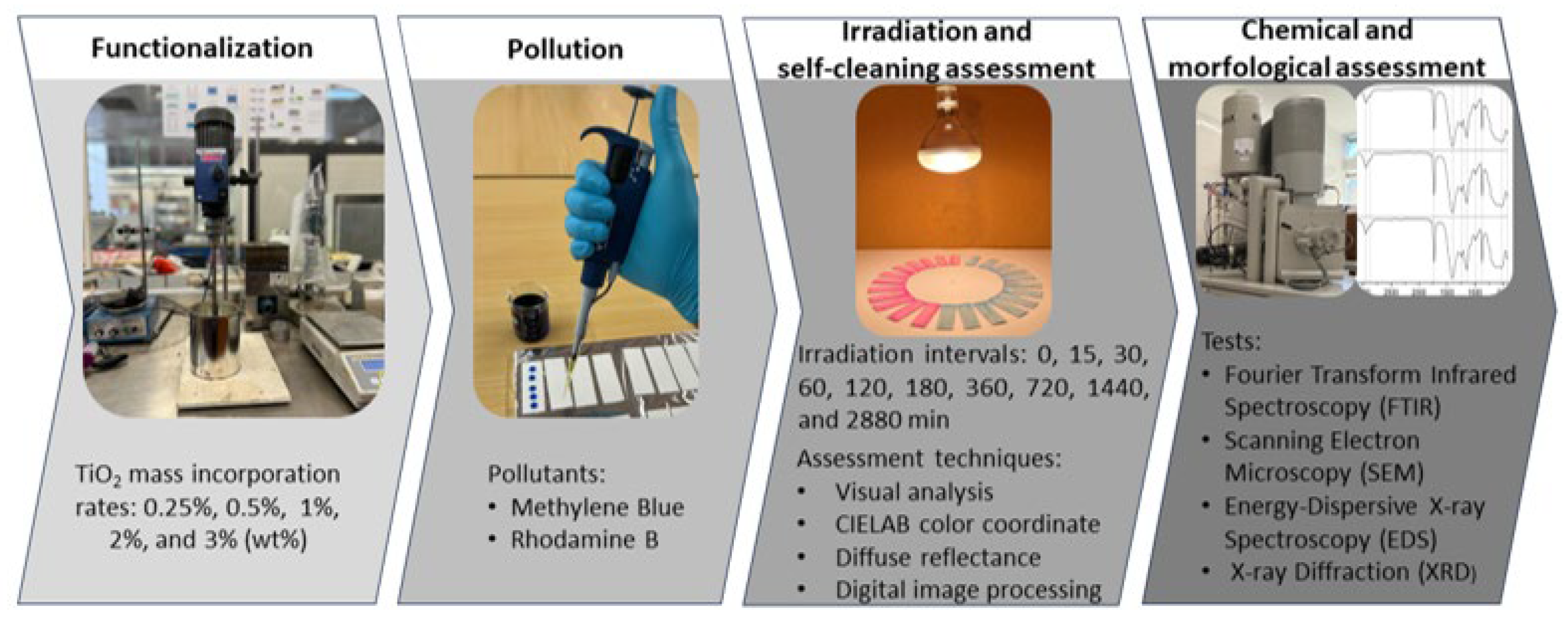

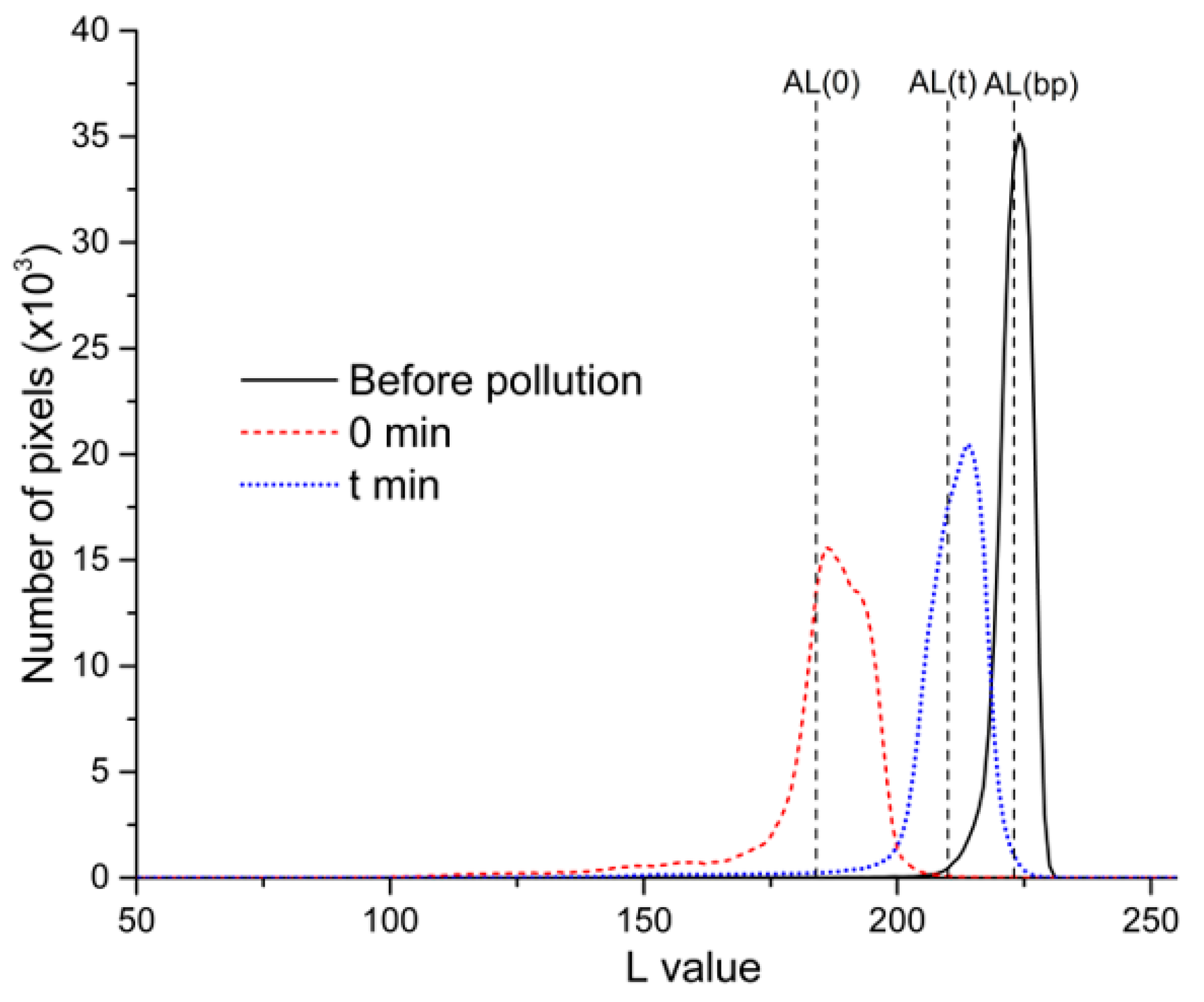
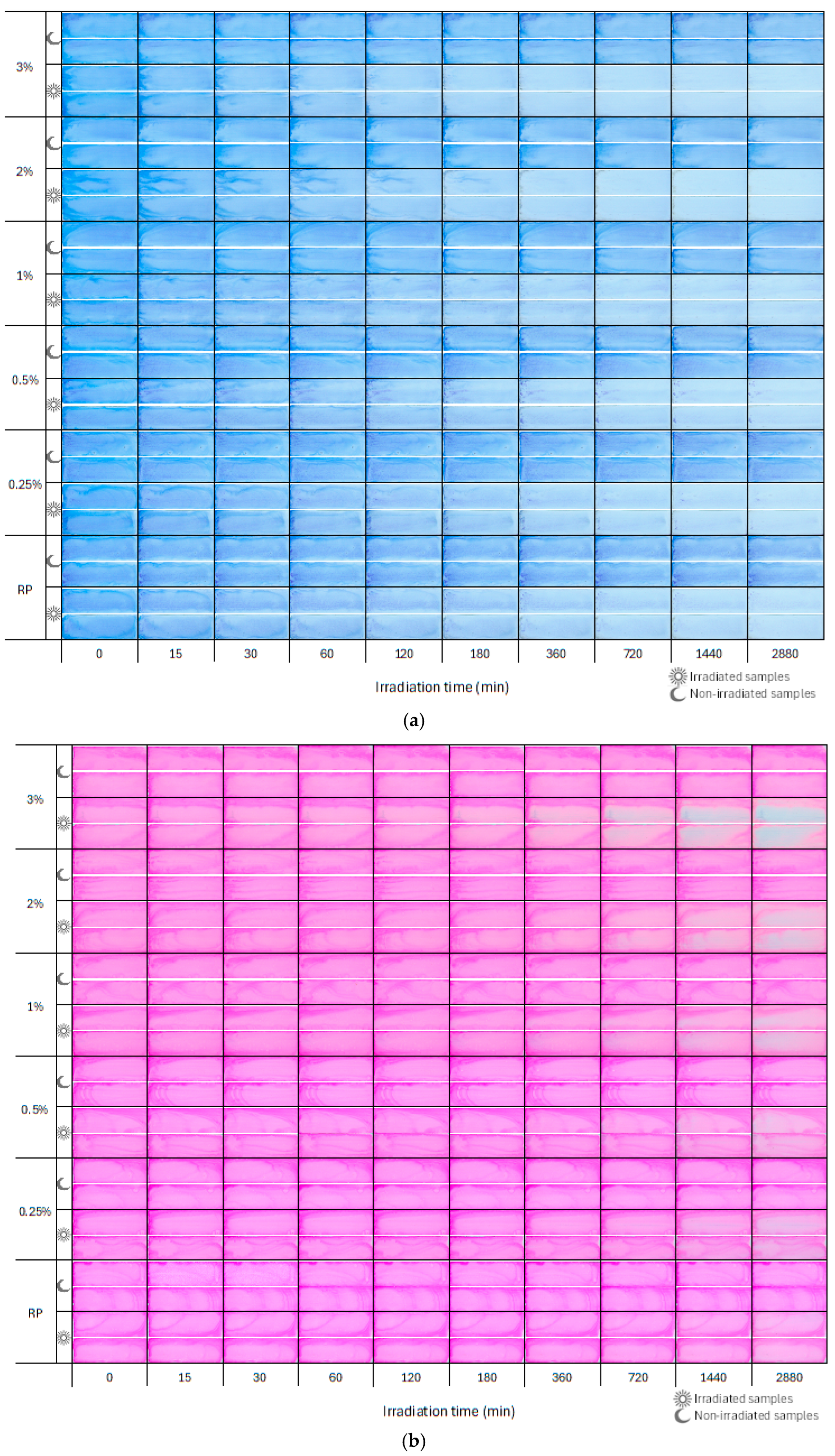
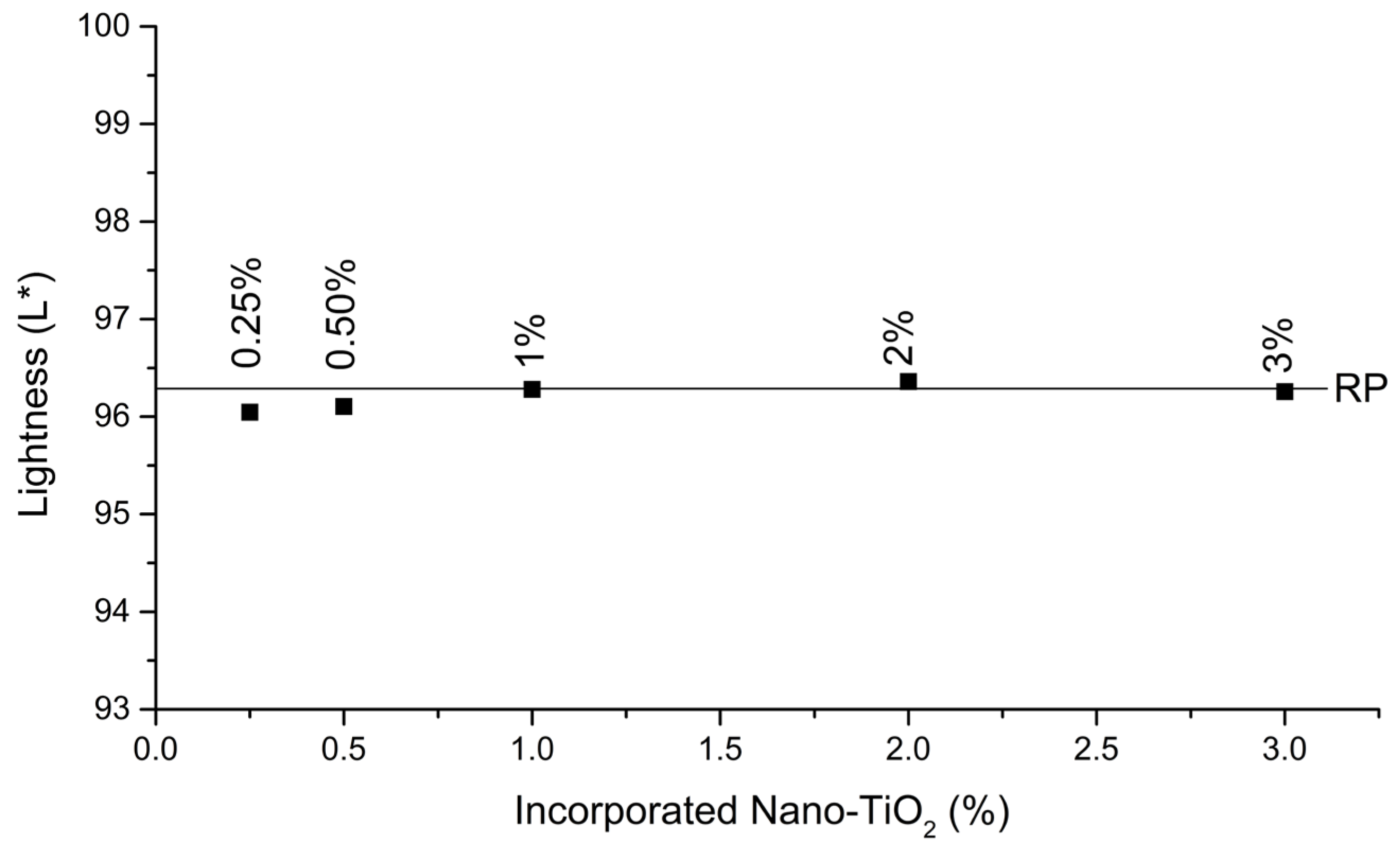


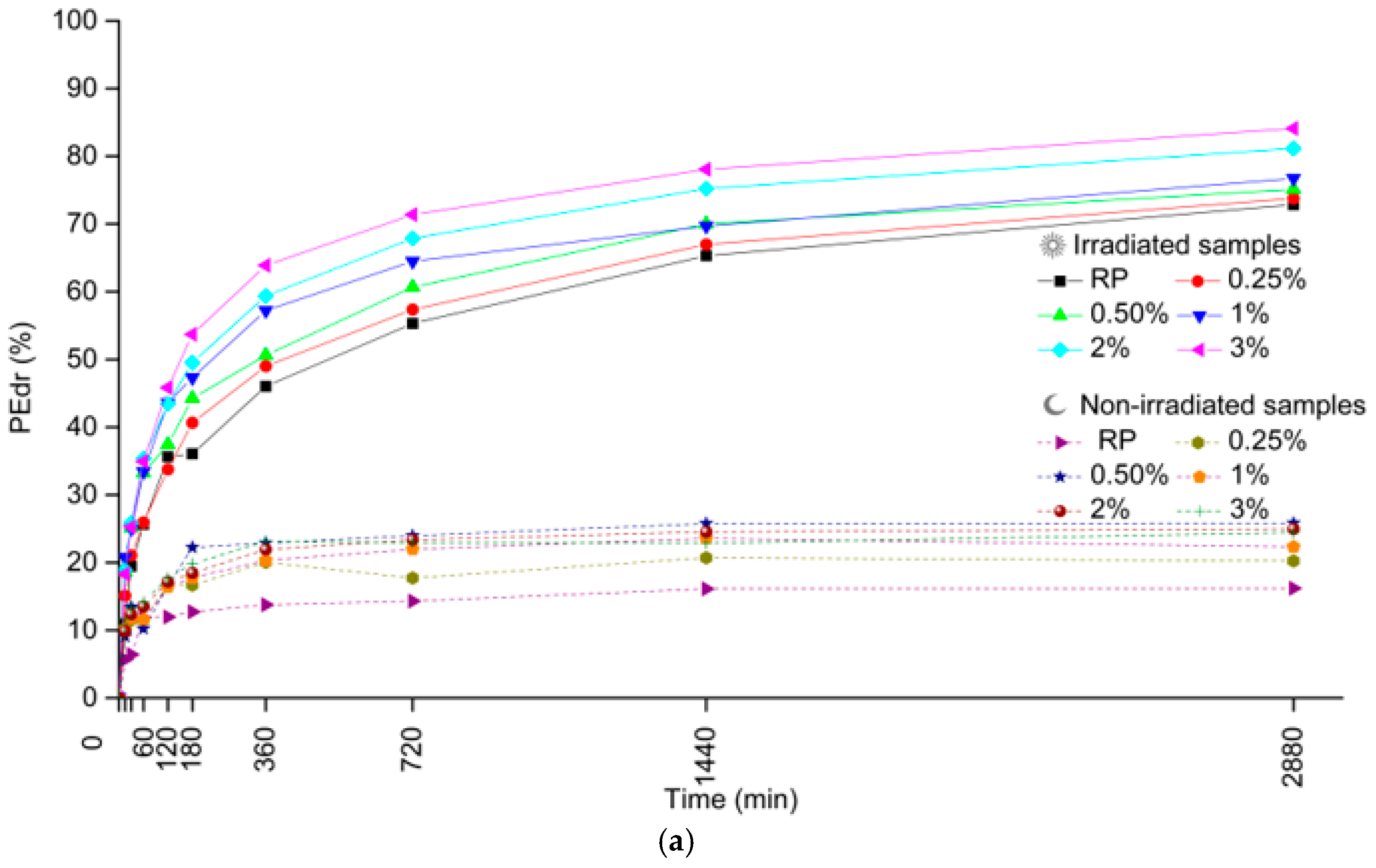
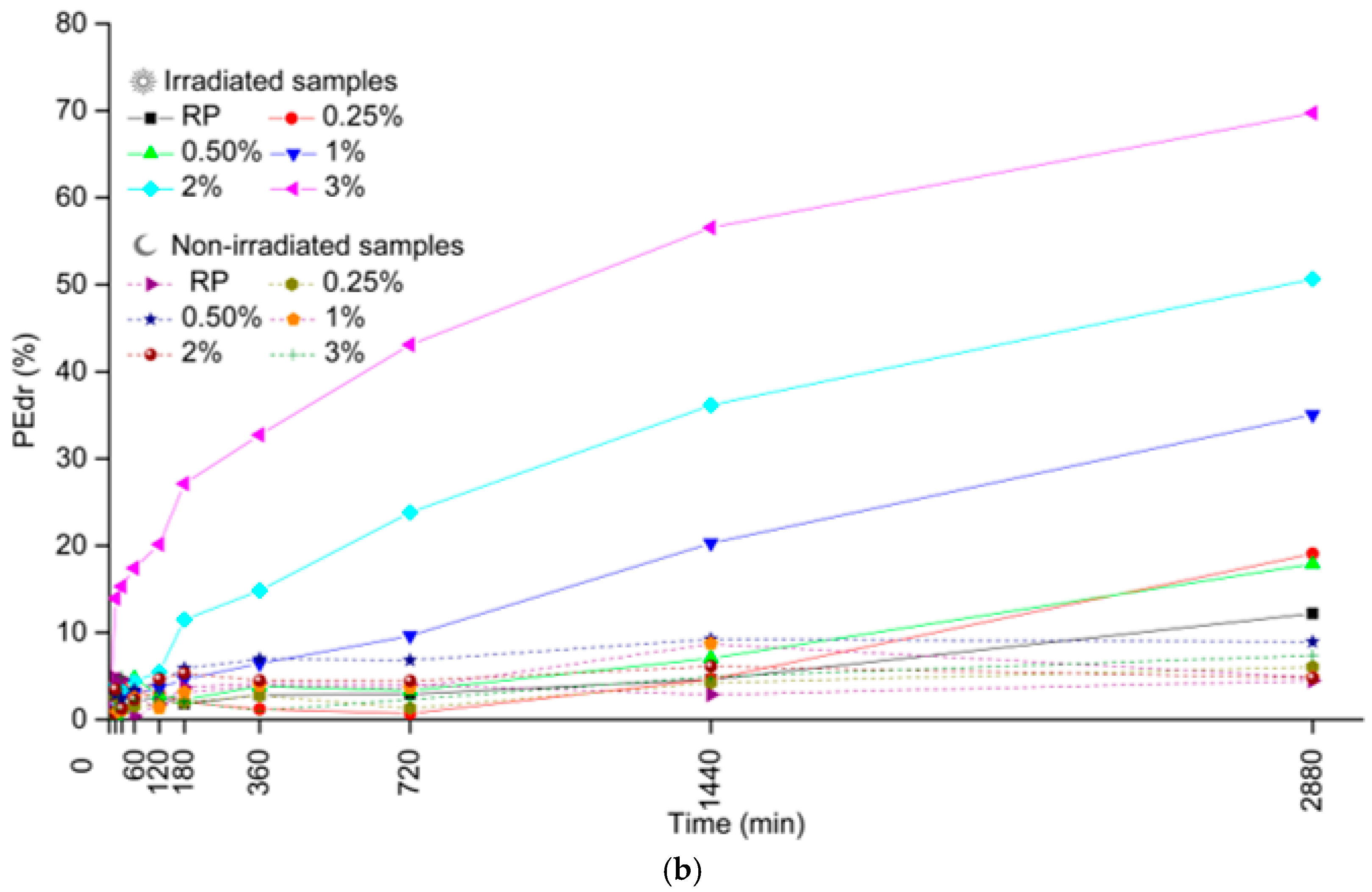
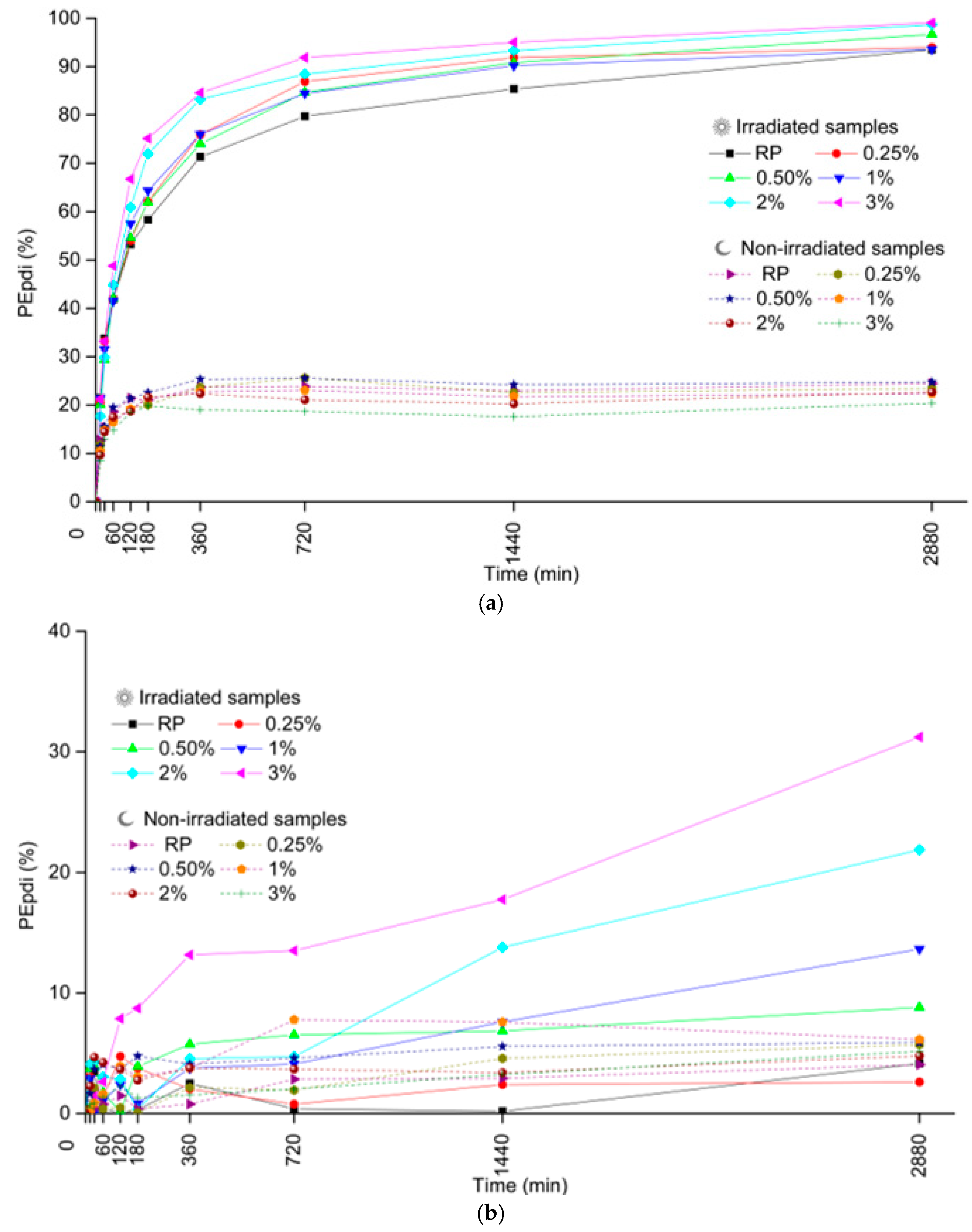
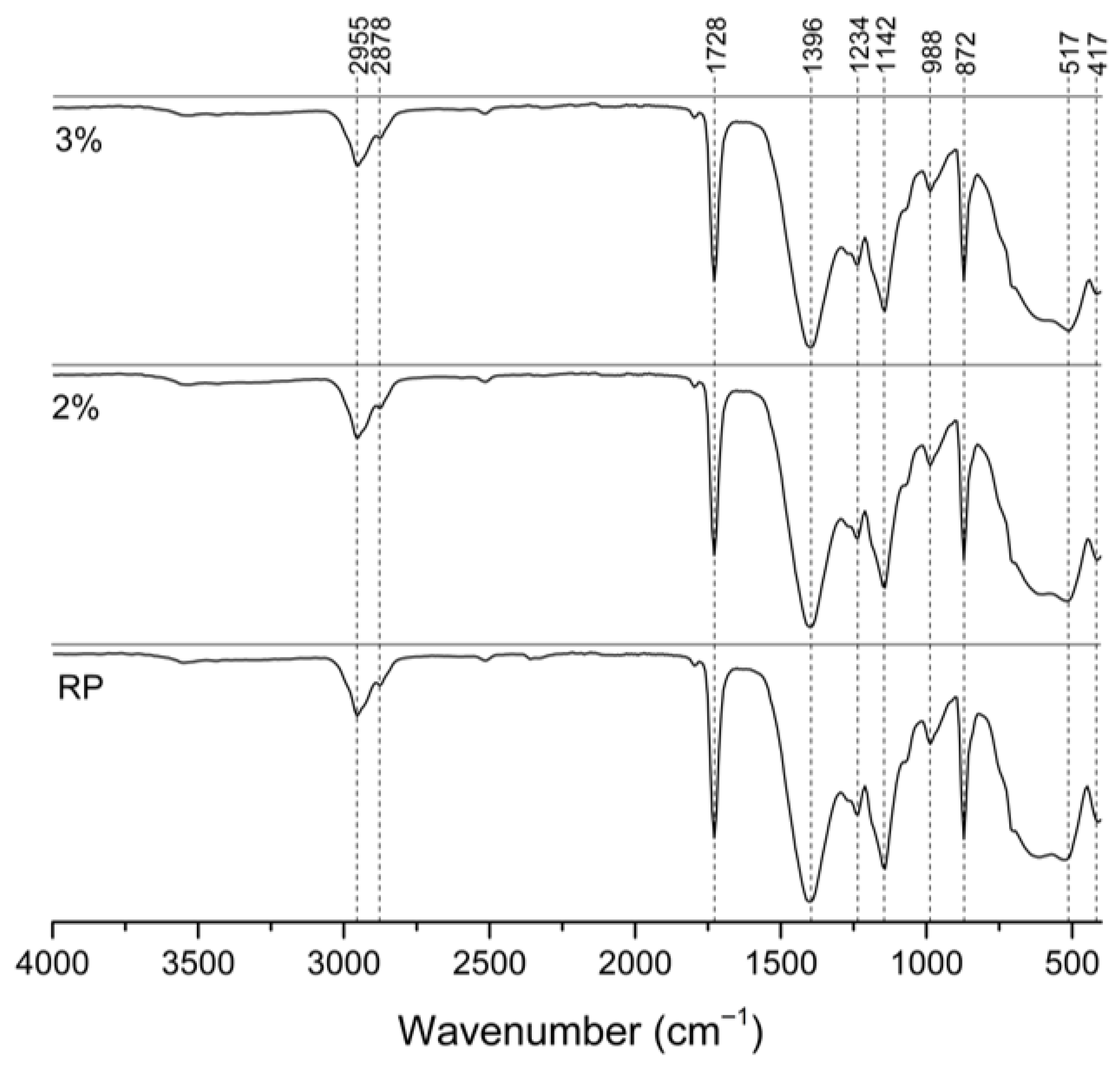




| RM Paint Characteristics | Declared Values |
|---|---|
| Luminance factor, β | β ≥ 0.85; class LF7 |
| Chromatic coordinates (x, y) | x, y within the polygon defined for white color |
| Density | 1.67 ± 0.04 g/cm3 |
| Solid content | 80.0% ± 2 |
| Ash content | 37.6% ± 3 |
| Coverage capacity | cr ≥ 95%; class HP4 |
| UVB aging | Δß ≤ 0.05; class UV1 |
| Storage stability | ≥4 |
| Nano-TiO2 Characteristics | Declared Values |
|---|---|
| Particle size | 23–28 nm |
| Appearance | White powder |
| Purity | >99.5% |
| Crystalline phases | 80% anatase, 20% rutile |
| Sample | Chemical Composition Wt (%) | |||
|---|---|---|---|---|
| C | O | Ca | Ti | |
| RP | 35.88 | 44.34 | 13.98 | 5.80 |
| 2% | 35.26 | 44.80 | 12.74 | 7.20 |
| 3% | 34.00 | 44.63 | 12.96 | 8.41 |
| Sample | Crystallite Size (nm) | ||
|---|---|---|---|
| CaCO3 | TiO2, Anatase | TiO2, Rutile | |
| RP | 39.3502 | - | 47.6597 |
| 2% | 35.4689 | 23.7546 | 45.1217 |
| 3% | 38.3040 | 22.3782 | 40.5887 |
Disclaimer/Publisher’s Note: The statements, opinions and data contained in all publications are solely those of the individual author(s) and contributor(s) and not of MDPI and/or the editor(s). MDPI and/or the editor(s) disclaim responsibility for any injury to people or property resulting from any ideas, methods, instructions or products referred to in the content. |
© 2025 by the authors. Licensee MDPI, Basel, Switzerland. This article is an open access article distributed under the terms and conditions of the Creative Commons Attribution (CC BY) license (https://creativecommons.org/licenses/by/4.0/).
Share and Cite
Lima, O., Jr.; Segundo, I.R.; Mazzoni, L.; Freitas, E.; Carneiro, J. Self-Cleaning Road Marking Paints for Improved Road Safety: Multi-Scale Characterization and Performance Evaluation Using Rhodamine B and Methylene Blue as Model Pollutants. Coatings 2025, 15, 1349. https://doi.org/10.3390/coatings15111349
Lima O Jr., Segundo IR, Mazzoni L, Freitas E, Carneiro J. Self-Cleaning Road Marking Paints for Improved Road Safety: Multi-Scale Characterization and Performance Evaluation Using Rhodamine B and Methylene Blue as Model Pollutants. Coatings. 2025; 15(11):1349. https://doi.org/10.3390/coatings15111349
Chicago/Turabian StyleLima, Orlando, Jr., Iran Rocha Segundo, Laura Mazzoni, Elisabete Freitas, and Joaquim Carneiro. 2025. "Self-Cleaning Road Marking Paints for Improved Road Safety: Multi-Scale Characterization and Performance Evaluation Using Rhodamine B and Methylene Blue as Model Pollutants" Coatings 15, no. 11: 1349. https://doi.org/10.3390/coatings15111349
APA StyleLima, O., Jr., Segundo, I. R., Mazzoni, L., Freitas, E., & Carneiro, J. (2025). Self-Cleaning Road Marking Paints for Improved Road Safety: Multi-Scale Characterization and Performance Evaluation Using Rhodamine B and Methylene Blue as Model Pollutants. Coatings, 15(11), 1349. https://doi.org/10.3390/coatings15111349









